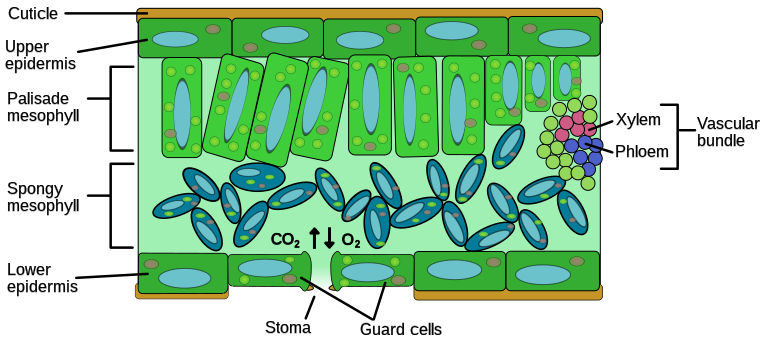READ: Plants
9. Leaves
Leaves
Leaves are the keys not only to plant life but to all terrestrial life. The primary role of leaves is to collect sunlight and make food by photosynthesis. Despite the fundamental importance of the work they do, there is great diversity in the leaves of plants. However, given the diversity of habitats in which plants live, it’s not surprising that there is no single best way to collect solar energy for photosynthesis.
Leaf Variation
Leaves may vary in size, shape, and their arrangement on stems. Nonflowering vascular plants have three basic types of leaves: microphylls (“tiny leaves”), fronds, and needles. Figure below describes each type.
Leaf variation in nonflowering plants reflects their evolutionary origins. Can you explain how?
Flowering vascular plants also have diverse leaves. However, the leaves of all flowering plants have two basic parts in common: the blade and petiole (see Figure above). The blade of the leaf is the relatively wide, flat part of the leaf that gathers sunlight and undergoes photosynthesis. The petiole is the part that attaches the leaf to a stem of the plant. This occurs at a node.
Flowering plant leaves vary in how the leaves are arranged on the stem and how the blade is divided. This is illustrated in Figure below. Generally, the form and arrangement of leaves maximizes light exposure while conserving water, reducing wind resistance, or benefiting the plant in some other way in its particular habitat.
- Leaves arranged in whorls encircle upright stems at intervals. They collect sunlight from all directions.
- Leaves arranged in basal rosettes take advantage of warm temperatures near the ground.
- Leaves arranged in alternate or opposing pairs collect light from above. They are typically found on plants with a single, upright stem.
- The blades of simple leaves are not divided. This provides the maximum surface area for collecting sunlight.
- The blades of compound leaves are divided into many smaller leaflets. This reduces wind resistance and water loss.

Leaf variation in flowering plants may include variations in the arrangement of leaves and the divisions of the blade.
Factories for Photosynthesis
You can think of a single leaf as a photosynthesis factory. A factory has specialized machines to produce a product. It’s also connected to a transportation system that supplies it with raw materials and carries away the finished product. In all these ways, a leaf resembles a factory. The cross section of a leaf in Figure below lets you look inside a leaf “factory.”

There are many specialized cells in the leaf.
A leaf consists of several different kinds of specialized tissues that work together to make food by photosynthesis. The major tissues are mesophyll, veins, and epidermis.
- Mesophyll makes up most of the leaf’s interior. This is where photosynthesis occurs. Mesophyll consists mainly of parenchymal cells with chloroplasts.
- Veins are made primarily of xylem and phloem. They transport water and minerals to the cells of leaves and carry away dissolved sugar.
- The epidermis of the leaf consists of a single layer of tightly-packed dermal cells. They secrete waxy cuticle to prevent evaporation of water from the leaf. The epidermis has tiny pores calledstomata (singular, stoma) that control transpiration and gas exchange with the air. Figure below explains how stomata carry out this vital function.
For photosynthesis, stomata must control the transpiration of water vapor and the exchange of carbon dioxide and oxygen. Stomata are flanked by guard cells that swell or shrink by taking in or losing water through osmosis. When they do, they open or close the stomata.
Seasonal Changes in Leaves
Even if you don’t live in a place where leaves turn color in the fall, no doubt you’ve seen photos of their “fall colors” (see Figure below). The leaves of many plants turn from green to other, glorious colors during autumn each year. The change is triggered by shorter days and cooler temperatures. Leaves respond to these environmental stimuli by producing less chlorophyll. This allows other leaf pigments—such as oranges and yellows—to be seen.

A deciduous tree goes through dramatic seasonal changes each year. Can you identify the seasons in the photo?
After leaves turn color in the fall, they may all fall off the plant for the winter. Plants that shed their leaves seasonally each year are called deciduous plants. Shedding leaves is a strategy for reducing water loss during seasons of extreme dryness. On the downside, the plant must grow new leaves in the spring, and that takes a lot of energy and matter. Some plants may “bank” energy over the winter by storing food. That way, they are ready to grow new leaves as soon as spring arrives.
Evergreen plants have a different strategy for adapting to seasonal dryness. They don’t waste energy and matter growing new leaves each year. Instead, they keep their leaves and stay green year-round. However, to reduce water loss, they have needle-like leaves with very thick cuticle. On the downside, needle-like leaves reduce the surface area for collecting sunlight. This is one reason that needles may be especially rich in chlorophyll, as you can see from the dark green pine needles in Figure below. This is also an important adaptation for low levels of sunlight, allowing evergreens to live far from the equator.
CK-12 Foundation, Biology. http://creativecommons.org/licenses/by-nc-sa/3.0/

Compare the color of the evergreen needles and the deciduous leaf. Why is the darker color of the needles adaptive?